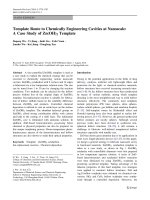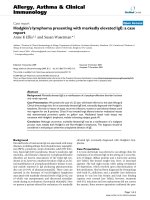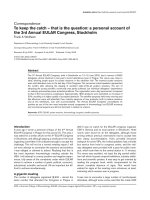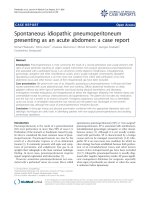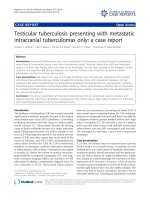Báo cáo y học: "Learning lessons from field surveys in humanitarian contexts: a case study of field surveys conducted in North Kivu, DRC 2006-2008" pot
Bạn đang xem bản rút gọn của tài liệu. Xem và tải ngay bản đầy đủ của tài liệu tại đây (562.11 KB, 8 trang )
BioMed Central
Open Access
Page 1 of 8
(page number not for citation purposes)
Conflict and Health
Short report
Learning lessons from field surveys in humanitarian
contexts: a case study of field surveys conducted in North Kivu, DRC
2006-2008
Rebecca F Grais*
1
, Francisco J Luquero
1,2
, Emmanuel Grellety
1
,
Heloise Pham
1
, Benjamin Coghlan
3
and Pierre Salignon
4
Address:
1
Epicentre, 8 rue Saint Sabin, 75011 Paris, France,
2
European Programme for Intervention Epidemiology Training, European Centre for
Disease Prevention and Control, Stockholm, Sweden,
3
Centre for International Health, Burnet Institute, Melbourne, Australia and
4
Health and
Nutrition Tracking Service, Geneva, Switzerland
Email: Rebecca F Grais* - ; Francisco J Luquero - ;
Emmanuel Grellety - ; Heloise Pham - ;
Benjamin Coghlan - ; Pierre Salignon -
* Corresponding author
Abstract
Survey estimates of mortality and malnutrition are commonly used to guide humanitarian decision-
making. Currently, different methods of conducting field surveys are the subject of debate among
epidemiologists. Beyond the technical arguments, decision makers may find it difficult to
conceptualize what the estimates actually mean. For instance, what makes this particular situation
an emergency? And how should the operational response be adapted accordingly. This brings into
question not only the quality of the survey methodology, but also the difficulties epidemiologists
face in interpreting results and selecting the most important information to guide operations. As a
case study, we reviewed mortality and nutritional surveys conducted in North Kivu, Democratic
Republic of Congo (DRC) published from January 2006 to January 2009. We performed a PubMed/
Medline search for published articles and scanned publicly available humanitarian databases and
clearinghouses for grey literature. To evaluate the surveys, we developed minimum reporting
criteria based on available guidelines and selected peer-review articles. We identified 38 reports
through our search strategy; three surveys met our inclusion criteria. The surveys varied in
methodological quality. Reporting against minimum criteria was generally good, but presentation of
ethical procedures, raw data and survey limitations were missed in all surveys. All surveys also failed
to consider contextual factors important for data interpretation. From this review, we conclude
that mechanisms to ensure sound survey design and conduct must be implemented by operational
organisations to improve data quality and reporting. Training in data interpretation would also be
useful. Novel survey methods should be trialled and prospective data gathering (surveillance)
employed wherever feasible.
Published: 10 September 2009
Conflict and Health 2009, 3:8 doi:10.1186/1752-1505-3-8
Received: 18 May 2009
Accepted: 10 September 2009
This article is available from: />© 2009 Grais et al; licensee BioMed Central Ltd.
This is an Open Access article distributed under the terms of the Creative Commons Attribution License ( />),
which permits unrestricted use, distribution, and reproduction in any medium, provided the original work is properly cited.
Conflict and Health 2009, 3:8 />Page 2 of 8
(page number not for citation purposes)
Introduction
In media and agency reports on complex emergencies, an
estimate of the number of people who have died, the prev-
alence of childhood malnutrition and other key health
indicators are often quoted. Although a discriminating
reader may understand that these are estimates, we rarely
question how or from where these numbers come. In
most cases, estimates are obtained by means of field sur-
veys which are subject to a number of limitations. In the
past, the application of standard survey methods by vari-
ous humanitarian actors has been criticised [1]. Currently,
different methods of conducting field surveys are the sub-
ject of debate among epidemiologists and their strengths
and weakness have been described in the literature [2-6].
Beyond the technical arguments, decision makers may
find it difficult to conceptualize what the estimates actu-
ally mean. For instance, what makes this particular situa-
tion an emergency? And how should the operational
response - humanitarian, political, even military - be
adapted accordingly [7,8]? This brings into question not
only the quality of the survey methodology, but also the
difficulties epidemiologists face in interpreting results and
selecting the most important information to guide opera-
tions.
As a case study, we reviewed publicly available field sur-
veys of a current acute-on-chronic humanitarian crisis -
North Kivu, Democratic Republic of Congo (DRC) - to
examine the methodologies employed, the findings pre-
sented, the interpretation of the results and the recom-
mendations made. The eastern DRC Province of North
Kivu has been the scene of conflict that has erupted spo-
radically for over a decade (Figure 1). The most recent
renewal of violence has forced some 250,000 people to
flee their homes since August 2008 [9].
Methods
We searched PubMed/Medline for articles published from
January 1, 2006 to January 1, 2009, in English, French,
German, and Spanish using the key words ["mortality"
(major topic) OR "nutrition" (major topic)] AND
["Congo" (text word) OR "Democratic Republic of
Congo" OR "North Kivu"]. To identify non-peer-reviewed
reports, we performed the same search in: (i) the Human
Impact of Complex Emergencies Complex (CE-DAT)
database; (ii) Relief-Web (a media and NGO repository
maintained by the Office for the Coordination of Human-
itarian Affairs); (iii) RDC-humanitaire.net; and (iv) the
websites of selected large international NGOs (the Inter-
national Rescue Committee, Merlin, Action Contre la
Faim, UNICEF, UNHCR, and Médecins Sans Frontières).
We also contacted the individual organizations above and
also requested additional information from the Health
and Nutrition Tracking Service (HNTS).
Inclusion criteria were a written report with, at minimum:
1. an estimate of the crude mortality rate (CMR); 2. the
under five mortality rate (U5MR); and 3. the prevalence of
global (GAM) and severe acute malnutrition (SAM) in the
surveyed population. We excluded meta-analyses, com-
mentaries, reports on DRC with no specific information
about North Kivu, multi-sector agency evaluations not
based on a survey, humanitarian action plans and rapid
assessments of small or non-randomized populations. We
drew from criteria proposed by Mills et al. [10], Checchi
and Roberts [11], the STROBE guidelines [12] and the
SMART initiative [13] to review the publications and to
propose a standard reporting format for field surveys.
Review criteria included those common to the published
work [10-13] in addition to drawing from the authors
experiences.
Results
We identified 38 agency reports through our search strat-
egy (Figure 2): seven from PubMed/MEDLINE, four
through CE-DAT, one through Reliefweb, 23 from RDC-
humanitaire.net, and three via individual web-sites. No
additional reports were identified through citations. We
were able to obtain 36 of the 38 reports. (The two docu-
ments we could not source were a rapid field assessment
conducted by Action Contre la Faim in November 2008,
and a nutritional survey conducted by World Vision in
Rwanguba health zone in March 2007.) Only three of the
36 surveys met our inclusion criteria. We excluded 22
multi-sector evaluations, two humanitarian action plans,
one survey covering the entire country but without spe-
cific mention of North Kivu, and one country-wide survey
of mortality without a nutritional assessment.
All three surveys were conducted by respected interna-
tional non-governmental organizations (NGOs) during
2008: Action Contre la Faim (ACF) [14], Cooperazione
Internazionale (COOPI) [15] and Epicentre [16]. All
reported similar results for CMR, U5MR and prevalence of
malnutrition (see table 1 and table 2), and all assessed
measles vaccination coverage. Two of the studies also
assessed other health indicators.
Discussion
While three surveys is a small sample to review, several
important lessons can still be learned about how field sur-
veys should be conducted, how they should be reported,
and what they should be expected to achieve. First,
although surveys may be designed by seasoned field epi-
demiologists, many are performed by less qualified and
experienced staff which can lead to methodological short-
comings. For example, one survey sampled the first 30
households at the center of each cluster, a mistaken appli-
cation of the WHO EPI survey methodology [17] biasing
Conflict and Health 2009, 3:8 />Page 3 of 8
(page number not for citation purposes)
Map of North Kivu, Democratic Republic of CongoFigure 1
Map of North Kivu, Democratic Republic of Congo.
Conflict and Health 2009, 3:8 />Page 4 of 8
(page number not for citation purposes)
their sampling. Such errors waste limited resources and
can result in programmatic decisions based on misleading
data. Currently, there is no formal mechanism for organi-
zations to have survey protocols reviewed - which may
mean protocols do not even get written. Ethical approval
may be routine practice for many organizations to prevent
harm to participants, but there remains no adequate
means to discuss survey design, survey instruments or
even concerns about the need for surveys. Such technical
and contextual issues may not be well understood by eth-
ical review boards, but may certainly impact on the ethics
of conducting the study. Having experienced staff review
survey protocols before data collection begins can
improve the chances that surveys will provide informative
data. More formal review of surveys meant for advocacy
purposes can help ensure they will be met with greater
acceptance. The recently formed Expert Review Group of
the HNTS, or another similar body, such as the Technical
Advisory Group of SMART, could be suitable bodies for
peer-review of protocols if accomplished in a timely man-
ner. This would go some way to helping prevent the con-
duct of substandard (and consequently unethical) surveys
and improve the overall quality of information collected.
Flow diagram of surveys included in the analysisFigure 2
Flow diagram of surveys included in the analysis.
7 abstracts identified
in Pubmed database
(peer –reviewed)
22 multisectorial evaluations
(Unicef and Norwegian
Refugee Council) excluded
7 excluded
29 full-text articles
assessed
31 studies identified in
NGO’s databases
(non-peer reviewed)
2 surveys not found
2 Humanitarian action
plans (OCHA) excluded
1 survey on DRC
excluded (EDS/RDC)
1 survey only on
mortality
Application of
inclusion criteria
Internet search of online databases
3 surveys
included for review
Table 1: Description of methodology for reviewed surveys
No.
(Ref)
Time Place Rationale Objectives Method Population Recall period
for mortality
1 (14) June 2008 Kibua ؠ This is the first
mortality and
nutritional
assessment
performed in Kibua
(performed by this
NGO).
ؠ To estimate the prevalence of
acute and chronic malnutrition
among children 6-59 months
ؠ To determine the crude and
the under five mortality rate
ؠ To estimate the measles
vaccine coverage
ؠ To estimate the vitamin A
supplementation coverage
ؠ To assess the deparasitation
among children with
Mebendazol
Two-stage
household
based cluster
sampling
81,174 90 days
2 (15) July 2008 Binza ؠ The NGO
implemented a
nutritional program in
2008 and provides
technical, financial and
material support to
the nutritional
centers operated by a
national NGO.
ؠ To estimate the prevalence of
acute and chronic malnutrition
among children 6-59 months
ؠ To determine the crude and
the under five mortality rate
ؠ To estimate the measles
vaccine coverage
ؠ To estimate the vitamin A
supplementation coverage
ؠ To assess the feeding practices
among young children
Cluster based
sampling
102,284 90 days
3 (16) July-
August
2008
Nyanzale,
Birambizo
ؠ To provide
humanitarian aide
adapted to the
displaced population
ؠ Follow the heath
situation in the
displaced camps in
the region of
Nyanzale
ؠ To assess the mortality rate
ؠ To assess the nutritional status
of the children
ؠ To evaluate the measles
vaccination coverage
ؠ To implement a mortality
surveillance system
Systematic
sampling
1701
households
60 days
Conflict and Health 2009, 3:8 />Page 5 of 8
(page number not for citation purposes)
Unlike other areas of epidemiology, for example, the
CONSORT [18] and STROBE [12] guidelines for clinical
trials and observational studies, there are no standardized
reporting guidelines for field surveys in humanitarian
contexts. Reporting standards offer a way for epidemiolo-
gists to prepare survey reports, improve transparency, and
facilitate critical appraisal and interpretation. The Stand-
ardized Monitoring and Assessment of Relief and Transi-
tions (SMART) initiative aims to ensure standardization
of planning, training, analysis and reporting [13], and
advocates for the systematic use of mortality and nutrition
indicators. The evaluation criteria presented in table 3 and
table 4, is a first step towards developing a checklist for
field surveys conducted in humanitarian contexts. For the
three surveys we reviewed, reporting of ethical considera-
tions, procedures for dealing with empty households, raw
data and survey limitations were commonly missed. Fol-
low-up actions for using the information were lacking for
two of the three studies. In general, however, the three sur-
veys we reviewed fulfilled most of the criteria.
Nonetheless, adherence to reporting standards by itself
does not guarantee that useful information will be pre-
sented. The three surveys made similar conclusions but
commonly failed to provide further qualification of the
findings. For example, measles vaccination coverage was
uniformly low, in all three surveys - one survey docu-
mented that 3.3% of children were vaccinated with card
confirmation, with 89% vaccinated according to parental
reporting. That study concluded that coverage was suffi-
cient, but neglected to discuss the limitations and assump-
tions concerning this estimate. Another recommended
that the 'health status of the population be improved'; a
non-specific recommendation inadequate to guide deci-
sion-making. Broader considerations of context were also
lacking in the interpretation of findings. For example,
nutritional assessments conducted at two different times
of the seasonal cycle may have the same result, but have
markedly different operational implications. None of the
three nutritional assessments we reviewed considered the
local seasonality of nutritional status. Appropriate timing
Table 2: Description of results and recommendations for reviewed surveys
No.
(Ref)
Time Place CMR
(per 10,000 per
day)
U5MR
(per 10,000 per
day)
GAM
(WHO)
SAM
(WHO)
Recommendations
1
(14)
June 2008 Kibua 0.38
[0.18-0.58]
1.10
[0.45-1.76]
4.8%
[3.2-6.3]
0.5%
[0.1-1.0]
ؠ Community awareness about key themes in
nutrition and encourage them to visit the NGO
for preventive consultations
ؠ Support the implementation of food security
assessment to improve food production and
diversity
ؠ Put in place a nutritional education system
ؠ Reinforce routine vaccination activities
ؠ Put in place comprehensive management of
acute malnutrition in health centers.
ؠ Improve the sources of potable water
2
(15)
July 2008 Binza 0.53
[0.30-0.76]
0.88
[0.25-1.51]
5.1%
[3.3-7.0]
1.0%
[0.3-1.7]
ؠ Continue activities for moderate malnutrition
to prevent the risk of severe malnutrition
ؠ Provide breastfeeding and nutritional
counselling
ؠ Support routine vaccination activities and
distribution of vitamin A
ؠ Improve the overall health status of the
population
3
(16)
July-
August
2008
Nyanzale,
Birambizo
0.48
[0.22-1.05]
1.08
[0.37-3.14]
2.6%
[1.4-4.5]
0.9%
[0.4-2.4]
ؠ Repeat the nutritional assessment the following
year at the same time using the same
methodology
ؠ Active screening of children's nutritional status
ؠ Put in place a prospective surveillance system
for morbidity and mortality
ؠ Strengthen routine measles immunization
strategies
ؠ Alert authorities to an abnormal increase in the
number of cases of malaria, diarrhea and measles
ؠ Community awareness campaign about the
NGOs activities
Conflict and Health 2009, 3:8 />Page 6 of 8
(page number not for citation purposes)
of surveys may therefore be another important factor in
guiding a meaningful intervention. For one of the surveys,
NGO staff were evacuated immediately after the survey as
security deteriorated (personal communication with
agency). Consequently, the survey results are of limited
value. While such events are not always predictable, local
circumstances must be considered when planning the
allocation of limited resources.
Since field surveys are usually conducted in settings where
routine health information systems are absent (such as
reporting of births and deaths, communicable and non-
communicable surveillance systems), they remain a fre-
quently used and valuable tool for informing interven-
tions. To maximise finite resources and appropriately
address health problems during humanitarian crises, it is
necessary that surveys using currently accepted methods
Table 3: Critical review criteria (background and methodology) and results of three reviewed surveys
Survey
(Ref)
1
(14)
2
(15)
3
(16)
Criteria
Background
Rationale ✓✓✓Explain the rationale for the survey
Objectives ✓✓✓State the objectives
Utilization ✓✓✓State how the results of the survey are to be used
(e.g. advocacy, program monitoring, baseline assessment)
Protocol ✓✓✓State who wrote the protocol for this survey
Methods
Setting ✓✓✓Describe the survey setting and relevant dates
Participants ✓✓✓Give the eligibility criteria for inclusion in the survey
✓✗✓State the definition of household
Variables ✓✓✓Define all outcomes and exposures
Survey instrument(s) ✓✓✓For each variable of interest, give sources of data and measurement methods.
Mention if secondary sources such as clinic records were consulted.
✓✓✓a) How was age ascertained?
✓✓✓b) How were deaths ascertained?
How were causes of death ascertained?
✓✗✓c) How were height (length), weight and oedema measured?
✗✓✓d) Reference the formulae and indicators used for nutritional prevalence, CMR
and U5MR
✗✓✓e) How was vaccination status determined (card, history, scar?)
Authorization and Ethical Considerations ✓✓✓Was authorization for this survey obtained?
✗✗✗State whether ethical approval approval was obtained
✗✗✗Describe the informed consent procedure
Bias ✗✗✗Describe any efforts to address potential sources of bias
Study size ✓✓✓State how the sample size was determined and provide all assumptions. including
but not limited to:
✗✓✓a) What design effect was assumed (cluster survey)?
b) What CMR (and U5MR) was assumed?
✗✓✓c) What prevalence of GAM/SAM was assumed?
✗✓✓d) What degree of precision is desired?
Survey Design ✓✓✓Describe survey sampling design
✓✓✓a) Describe household selection procedures
✗✗✗b) Describe procedures to revisit absent households
Survey Teams ✓✓✓Describe training procedures
✓✓✓State number of surveyors and their degree of professional training
✗✓✓State how the survey was piloted
Data Accuracy ✗✓✓Describe strategies to ensure data accuracy (e.g., double entry)
Statistical methods ✗✓✓a) Describe all statistical methods
✗✗✗b) Explain how missing data were addressed
✗✓✓d) Provide software used for statistical analyses
Conflict and Health 2009, 3:8 />Page 7 of 8
(page number not for citation purposes)
are well implemented. Further, organisations need to
cooperate in developing novel tools suitable for the
changing nature of humanitarian crises - for example,
there has been a shift towards displaced populations
being accommodated by existing host communities and
in informal settlements in urban settings rather than in
large refugee camps, yet survey methods for mortality and
nutritional assessments have barely evolved. Indeed, there
may be instances when establishing prospective surveil-
lance systems, however rudimentary, are preferable to the
tradition of periodic surveys, such as when organizations
are present in an area for an extended period. For all of us
involved in humanitarian crises, there is a clear need to
reflect on the role and conduct of field surveys and to look
beyond the standard methods for measuring mortality
and malnutrition.
Competing interests
All authors, except PS and BC, are employed by organiza-
tions which conducted the surveys reviewed in this man-
uscript.
Authors' contributions
RFG, FJL, HP, and EG had full access to all the data in the
study and take responsibility for the integrity of the data
and the accuracy of the data analysis. All authors partici-
pated in the conception and design of the study; analysis
and interpretation of data; drafting the paper and revising
it critically for substantial intellectual content. All authors
read and approved the final manuscript.
The Health Nutrition Tracking Service (HNTS) funded
this research.
References
1. Speigel PB, Salama P, Maloney S, Veen A van der: Quality of malnu-
trition assessment surveys conducted during famine in Ethi-
opia. JAMA 2004, 292(5):613-618.
2. World Food Program: A manual: Measuring and interpreting malnutrition
and mortality WFP: Rome; 2005.
3. Brown V, Checchi F, Depoortere E, Grais RF, Greenough PG, Hardy
C, Moren A, Richardson L, Rose AM, Soleman N, Spiegel PB, Sullivan
KM, Tatay M, Woodruff BA: Wanted: studies on mortality esti-
mation methods for humanitarian emergencies, suggestions
for future research. Emerg Themes Epidemiol 2007, 4(1):9.
4. Soleman N, Chandramohan D, Shibuya K: Verbal autopsy: current
practices and challenges. Bull World Health Organ 2006,
84(3):239-45.
Table 4: Critical review criteria (results and interpretation) and results of three reviewed surveys
Survey
(Ref)
1
(14)
2
(15)
3
(16)
Criteria
Results
Participants ✓✓✓a) Report number of individuals surveyed
✓✓✓b) Report non-participation (refusals)
✓✓✓c) Report number of households surveyed
✓✓✓d) Give characteristics of survey participants (e.g. demographic, clinical, social)
✗✗✓e) Indicate number of participants with missing data for each variable of interest
Main Results ✓✓✓Summarize key results with reference to survey objectives
✓✓✓a) Provide estimates and their precision (eg, 95% confidence interval with design effect if
cluster based sampling).
✗✗✗b) Report causes of death
✗✗✗c) Report absolute numbers of deaths
✗✗✗d) Report absolute numbers of other variables of interest
Limitations ✗✗✗Discuss limitations of the survey, taking into account sources of potential bias or imprecision.
Discuss both direction and magnitude of any potential bias
Interpretation
Interpretation ✓✓✓Give an overall interpretation of results considering objectives, limitations, results from similar
surveys, and other sources of information
Generalisability ✗✗✗Discuss the generalisability (external validity) of the study results
Funding ✓✓✓State the funding source for the survey
Conflict of interest statement ✗✗✗Provide statement concerning conflict of interests and if none, state this.
Follow-up ✗✗✓State to whom these results will be provided
Recommendations ✓✓✓Provide recommendations on a course(s) of action based on interpretation of findings
Publish with Bio Med Central and every
scientist can read your work free of charge
"BioMed Central will be the most significant development for
disseminating the results of biomedical research in our lifetime."
Sir Paul Nurse, Cancer Research UK
Your research papers will be:
available free of charge to the entire biomedical community
peer reviewed and published immediately upon acceptance
cited in PubMed and archived on PubMed Central
yours — you keep the copyright
Submit your manuscript here:
/>BioMedcentral
Conflict and Health 2009, 3:8 />Page 8 of 8
(page number not for citation purposes)
5. Turner AG, Magnani RJ, Shuaib M: A not quite as quick but much
cleaner alternative to the Expanded Programme on Immu-
nization (EPI) cluster survey design. Int J Epidemiol 1996,
25(1):198-203.
6. Grais RF, Rose AMC, Guthmann J-P: Don't spin the pen: Alterna-
tive methods for second-stage sampling in retrospective
cluster surveys. Emerg Themes Epidemiol 2007, 4(1):8.
7. National Research Council: Demographic Assessment Techniques in
Complex Humanitarian Emergencies: Summary of a Workshop. Holly
Reed, Rapporteur, Roundtable on the Demography of Forced Migration,
Committee on Population Washington, DC: National Academy Press;
2002.
8. Spiegel P: Differences in World Responses to Natural Disas-
ters and Complex Emergencies. JAMA 2005, 293:1915-1918.
9. See for example: European Commission Humanitarian Aid
(ECHO): Democratic Republic of Congo [ />echo/aid/sub_saharian/rdc_en.htm]
10. Mills EJ, Checchi F, Orbinski JJ, Schull MJ, Burkle FM Jr, Beyrer C,
Cooper C, Hardy C, Singh S, Garfield R, Woodruff BA, Guyatt GH:
Users' guides to the medical literature: how to use an article
about mortality in a humanitarian emergency. Conflict and
Health 2008, 2:9.
11. Checchi F, Roberts L: Interpreting and Using Mortality Data in Humani-
tarian Emergencies: A Primer for Non-epidemiologists, Network Paper 52
HPN: London; 2005.
12. The STROBE Initiative [ />]
13. Standardised Monitoring and Assessment of Relief and Transitions
(SMART): Measuring mortality, nutritional status, and food
security in crisis situations: SMART methodology. Protocol,
Version 1 2005 [ />SMART_Protocol_01-27-05.pdf].
14. Action Contra La Faim: Rapport d'Enquête Nutritionnelle
Anthropométrique, Zone de Santé de Kibua, Province Du
Nord Kivu, Juin 2008. [ />index.php?id=3]. (Accessed February 2009)
15. Rizzi D: Rapport d'Enquête Nutritionnelle et de Mortalité
dans la Zone de Santé de Binza Province du Nord Kivu,
République Démocratique du Congo, Juillet 2008, Cooper-
azione Internazionale. [ />index.php?id=3]. (Accessed February 2009)
16. Grellety E, Ronsse A: Retrospective Mortality Survey, North
Kivu. Epicentre, Médecins Sans Frontières 2008.
17. World Health Organization, Expanded Program on Immunization:
Training for mid-level managers: the EPI coverage survey. WHO/EPI/MLM/
91.10 WHO, Geneva; 1991.
18. The CONSORT Statement [ />]
